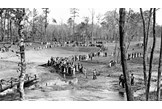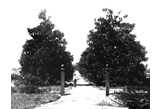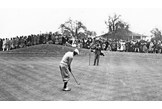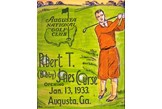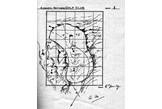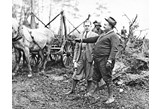Augusta 1934 - build it and they will come
Published:
Augusta, Georgia, the early 1930s. As he looked out across the 365-acre tract of land around him, New York banker Clifford Roberts felt his heart begin to dance.
“When I walked out on the grass terrace under the big trees and looked down over the property,” said the future first chairman of Augusta National, “the experience was unforgettable.” Roberts was standing in what we now know to be the Augusta National clubhouse, surveying the land that spread out before him. At that point, he saw past the former indigo plantation land. All he saw was a blank canvas and great potential, a view shared by his business partner, Bobby Jones. “Perfect!” remarked the legendary amateur, who since his retirement was keen to build his own course. “To think this land has been lying here all these years waiting for someone to come along and lay a golf course upon it,” he marvelled.
In Jones and Roberts, the land had found its ‘someone’, and with the help of British course architect Alister MacKenzie, with whom Jones shared a deep love of St Andrews, they set about laying down a course that realised their grand ambitions.
Augusta National Golf Club opened for play in 1933, but it wasn’t until the following year that it truly caught the public’s attention. During the early stages of the club’s development, Jones had petitioned the USGA to hold the US Open on his new course but been turned down on the grounds that Georgia’s hot summers made it unsuitable. Unperturbed, Jones and Roberts revised their plan and determined that the club would be better served by introducing a tournament of its own. And so a tournament was born.
It wasn’t The Masters, because Jones considered the name too pretentious, but instead The Augusta National Invitational, scheduled for March to accommodate the press returning from Spring baseball training camps in Florida. The tournament programme was emblazoned with ‘Annual Invitation Tournament’, though the newspapers and Roberts himself still referred to it as The Masters, the title it would not officially adopt until 1938.
The vision of Jones and Roberts may have been grand, but their plan was simple. “We realised that, in order to build a tournament of stature,” said Roberts, “it needed to be operated in a better fashion and made more enjoyable than any other.”
To that end, the atmosphere would resemble an intimate gathering of friends, fans and admirers of Bobby Jones. The great man insisted that all the invitees were treated like kings, so local members entertained players to lavish barbecues and a ‘chicken dinner’ held at the club.
After his retirement from the game, Jones warmed to the idea of using the tournament to catch up with old friends he didn’t see very often, but he didn’t want to feature in the event himself. Fearing his game was rusty and preferring the idea of being a tournament official, Jones forced Roberts into pointing out that without him teeing it up and topping the bill, their mission of establishing the Masters as a tournament of stature was destined to fail.
Roberts’ vision was to promote an event that would endure long after Jones had retired once again, which meant creating a tournament that would help sell memberships to the then cash-strapped club. His business plan called for 1,800 members paying dues of $60 each year – yet by the eve of the inaugural tournament, membership stood at 76. Asked to describe the club’s financial status at that point, Roberts claimed they were just “one jump ahead of the sheriff”. But this was very soon to change.
No fairytale ending
The Augusta National Invitational Tournament was held between March 22 and 25 of 1934, featuring a field of 72 players – 60 professionals and 12 amateurs. They competed for a comparatively meagre $5,000 in prize money, about half as much as many tournaments of the time, but the lure for the players and public alike was the return of Bobby Jones. Ticket sales had been healthy, with only the US Open selling more tickets that year.
Upon arrival, those fans found themselves at the forefront of a golfing revolution. The tournament was the first to provide ‘observation stands’ for their comfort, the first to feature scoreboards and the first to rope off the galleries from the fairways.
No less radical, it was also the first golf event ever to be broadcast nationwide, Roberts having paid NBC Radio to broadcast the event from a specially built tower standing by the 18th green.
Those fortunate enough to be present were afforded an experience unlike any other in golf at that time, but were denied the fairytale ending most had been hoping for. Their host Bobby Jones found his putting touch had deserted him and could only post rounds of 76, 74, 72 and 72, leaving him tied 13th with Walter Hagen. Both lagged 10 shots behind the eventual winner, Horton Smith, from Springfield, Missouri, who edged out Craig Wood by a stroke to take the $1,500 first prize.
“The opening act was an amazing success,” reflected the respected American sportswriter Grantland Rice, when the dust had settled. He, like everyone else, was buoyed by what he had witnessed over those four days, but blissfully unaware of what was to come. The rest, as they say, is history.

